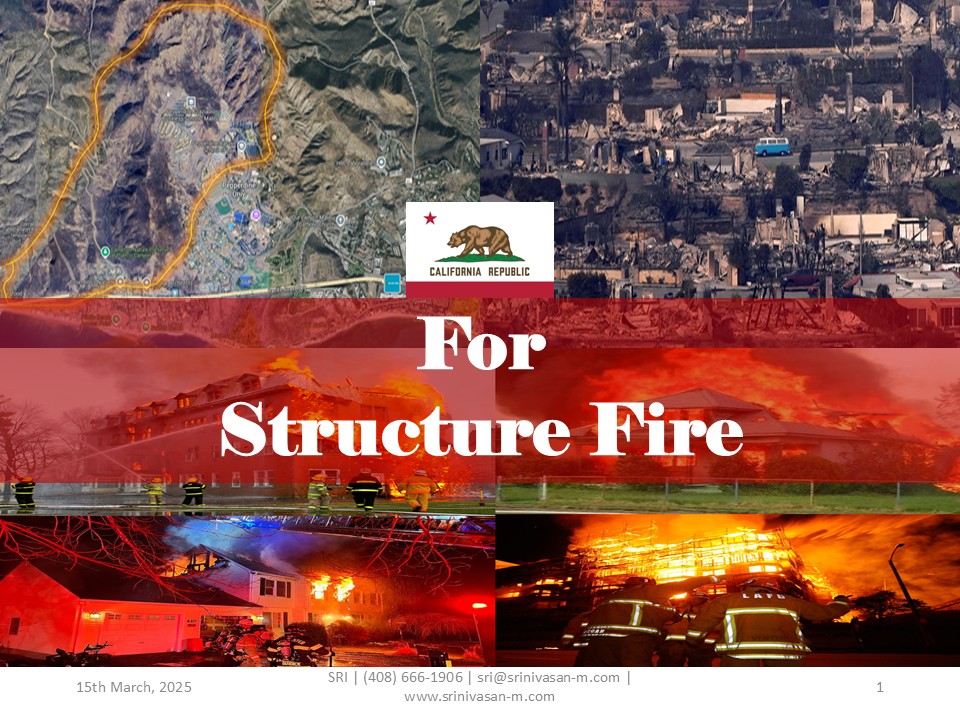WildFire mitigation Strategies proposal to Santa Clara County Emergency Operational Area Council
A Call for a Greener and Safer California
Dear Santa Clara County Emergency Operational Area Council,
As a proud resident from the Mission City in God’s country, it is disheartening to see our Golden State being reduced to ashes, taking countless lives—especially the helpless animals that suffer the unimaginable pain of being burned alive. While we focus on quenching the flames, we are not taking proactive measures to prevent wildfires and make California greener than ever before. Prevention is always better than cure.
I believe this is an issue that Santa Clara County can champion. With your leadership and collaboration, the county has the potential to create a lasting impact—protecting not just people but all living beings who call California home. While wildfire response efforts remain crucial, I urge you to consider proactive strategies that can help prevent future devastation and promote a more resilient, greener landscape.
I hope you will find the opportunity to review the wildfire mitigation document and take decisive action by working with the relevant departments and authorities to move this forward. Additionally, it would be helpful if you could provide some updates on the feasibility, challenges, and support required for implementing the recommendations outlined in my document.
Please feel free to reach out anytime if you need further clarification. My goal is to highlight the possibilities and leave it to the experts to implement solutions. Where there is a will, there is always a way.
Srinivasan (SRI) Manivannan
Proud Resident of Santa Clara
Wildfires and the Fight to Save Humanity in the USA
Current State: A Nation Under Fire
The United States is facing an unprecedented wildfire crisis. Every year, millions of acres are lost to flames, communities are displaced, and ecosystems are obliterated. The air is thick with smoke, and the economic toll is staggering. California, the epicenter of these disasters, is struggling with extreme heat, dry conditions, and insufficient fire prevention measures.
Future State: A Fire-Resilient America
The future of wildfire management must be proactive, not reactive. The vision for a fire-resilient America includes cutting-edge technology, sustainable land management, and coordinated emergency responses. By integrating remote monitoring, wildfire suppression strategies, and large-scale ecological restoration, the USA can transition from crisis response to long-term prevention.
Wildfire Prevention and Response Strategy
IoT Devices & Remote Management
Technology must be at the heart of wildfire prevention:
- Remote Sensors & AI Detection: IoT sensors installed in forests detect smoke, heat, and humidity changes, triggering early warnings.
- Drones & Satellites: Real-time monitoring of fire-prone zones, predicting fire behavior.
- Automated Fire Suppression: Smart sprinklers and aerial water systems that activate automatically.
Wildfire Workflow & Emergency Response
- Detection & Alert – IoT devices send alerts to emergency centers.
- Data Analysis – AI predicts fire spread and suggests containment strategies.
- Rapid Response Deployment – Firefighters, aircraft, and suppression chemicals are deployed in targeted areas.
- Evacuation & Safety Protocols – Immediate evacuation procedures based on real-time fire behavior.
Wildfire Dashboard & Alerts
- Real-time Fire Tracking – Updates on fire size, direction, and containment status.
- Resource Management – Live data on firefighter locations, water sources, and available suppression chemicals.
- Public Alerts & Evacuations – Automated warnings sent to residents in danger zones.
California’s Green Movement: A 10-Year Transformation (2025-2035)
Green Movement Strategies & Workflow
- Controlled Blasting & Artificial Reservoirs
- Creating water storage systems in mountainous terrains to combat drought and support fire suppression.
- Rainwater Harvesting & Aerial Reservoirs
- Capturing rainwater to replenish reservoirs and reduce fire risks.
- Aerial Seeding & Eutrophication
- Spreading fire-resistant plant seeds and using algae to restore water bodies.
- Rex Rabbit Propagation & Rewilding
- Reintroducing wildlife to help restore ecological balance.
- Beekeeping & Pollinator Support
- Strengthening ecosystems by increasing pollinator populations.
- Aerial Organic Waste & Seed Disposal
- Spreading compost and organic waste to fertilize fire-affected land.
- Sustainable Land Management
- Composting, mulching, and planting drought-tolerant vegetation to reduce fire hazards.
- Biodiversity & Habitat Restoration
- Reintroducing native species and creating habitats for displaced wildlife.
- Community Involvement
- Volunteer programs, tree planting, agroforestry, controlled grazing, and educational workshops.
Wildfire Damage Report & Suppression Strategies
Current Wildfire Impact in California
- Millions of acres lost annually
- Thousands of homes destroyed
- Billions of dollars in economic damage
- Severe health risks due to smoke inhalation
Future State of California: Option 1
- A comprehensive wildfire defense system
- Improved water conservation and distribution
- Increased forest restoration and fire-resistant landscaping
- Integration of AI-driven fire monitoring and suppression
Wildfire Suppression Technologies
- Extinguishing Foams & Suppressing Chemicals
- Temprotex FireFoam – Forms a barrier that blocks oxygen.
- Phos-Chek – Long-term retardant to prevent fire spread.
- FireIce – Cools and smothers flames instantly.
Wildfire: Remote Monitoring Workflow
- IoT Sensors & AI Detection – Identify potential fire outbreaks.
- Data Transmission & Alerts – Send real-time warnings to command centers.
- AI Analysis & Fire Behavior Prediction – Forecast fire movement.
- Automated Response Activation – Deploy drones, sprinklers, and suppression systems.
- Human Intervention & Evacuation – Mobilize emergency response teams.
Green Movement Flow: 2025-2035
- Immediate Implementation (2025-2028) – Controlled blasting, rainwater harvesting, and IoT monitoring.
- Mid-Term Goals (2029-2032) – Large-scale reforestation, biodiversity restoration, and community engagement.
- Long-Term Vision (2033-2035) – A fully fire-resilient California with a self-sustaining ecosystem.
Conclusion: A Call to Action
The USA is at a turning point. Wildfires are no longer just a natural disaster; they are a humanitarian crisis. By adopting cutting-edge wildfire prevention technology, restoring ecosystems, and committing to long-term sustainability, we can save lives, protect communities, and ensure a future where wildfires no longer define our reality.
The time to act is now. Will we rise to the challenge, or will we let our future burn?


















































